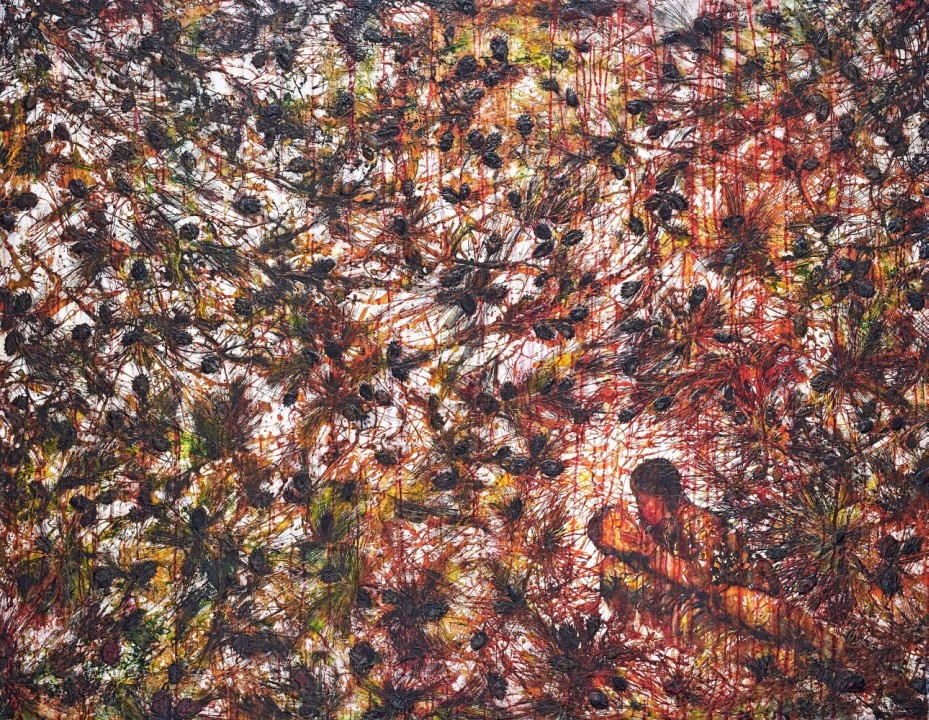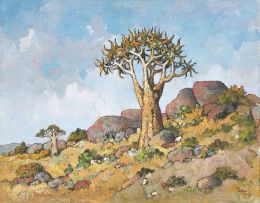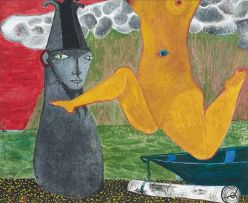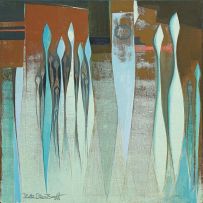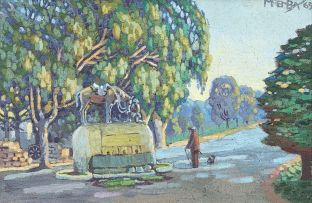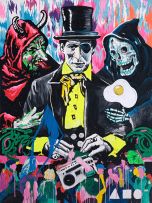Pine
Penny Siopis
Incl. Buyer's Premium & VAT
About this Item
Notes
"Penny Siopis is one of the few artists in the world today who can weave a material web of marks, gestures, voices, words, found things and painted surfaces to entangle the brute forces of history with the delicate threads of human vulnerability".1 So says Griselda Pollock, director of the Centre for Cultural Analysis, Theory and History and professor of Social and Critical Histories of Art at the University of Leeds.
Born in South Africa of Greek heritage, Penny Siopis obtained her Master in Fine Art degree from Rhodes University's Fine Art Department, an art school well known for its academic approach to painting. Throughout a career spanning several decades, Siopis has examined, challenged and redefined the genres of painting in unique ways. Early so-called 'cake paintings' and works such as Still Life with Watermelon and Other Things, which won her the Merit Award at the second Cape Town Triennial in 1985, freighted as they are with sexual references and cultural excess, challenge conventional notions of the still life genre. The particularities of local and colonial history, the dislocations of migration and immigration and the politics of Africa and South Africa, in particular, were central to her history paintings, installations and to a number of her films.
Her Shame works, exploring the social and intimate body, culminated in an exhibition, Three Essays on Shame at the Freud Museum, London in 2005, which marked the centenary of the publication of one of his most scandalous works. Never afraid to confront fears and phobias, her Pinky Pinky works explore the hidden dangers and terrors that lurk in the collective imagination.
Such complex iconography, however, has not been at the expense of the materiality of the medium which has always been a vital concern. Pine reveals a matrix of marks created across the canvas, in a way not unlike the Abstract Expressionist paintings of Jackson Pollock. Like him, Siopis will often work with the canvas flat on the floor, then tilt it, as in this case, to allow red ink to drip down its surface. Wood glue, purchased in Greece and possibly with a high resin content, pools in dark cones while spikes of green ink protrude like pine needles.
Pine is the first in a new body of work which was to be exhibited in 2009. The Athens School of Art had invited Siopis in the previous year to be artist-in-residence at their studio in Delphi, the seat of the oracle of Apollo. In the vicinity were pine forests, which she associated with partisans hiding out during Greece's protracted Civil War from 1945 to 1949. Following closely on the devastation of World War II, and with the intervention of Stalin and Churchill, it became the first battle of the Cold War. Political differences and warring factions caused deep schisms that rent many Greek families apart.
The work clearly pivots on the double entendre of its title - the pine forest is also the locus of pain and suffering or of yearning for something, of craving a different life. Two figures are located at the bottom right of a large field of expressive marks. Hidden amongst the pine boughs, they are enfolded in an intense embrace, the ambiguity of which leads one to question whether this is a clasp of tenderness or of suffocation. Are these friends or foes? Is this an erotic encounter or a life-and-death struggle?
The artist's stature has been acknowledged with an impressive retrospective entitled Penny Siopis: Time and Again, on view at Iziko South African National Gallery from 17 December 2014 to 23 March 2015, a modified version of which will be installed at the Wits Art Museum from April 2015. Her works are represented in most major museums and corporate collections throughout South Africa, in the World Bank, Washington as well as in local and international private collections.
1. Quoted on the cover of Gerrit Olivier (2014) Penny Siopis: Time and Again, Johannesburg: Wits University Press.
Exhibited
Michael Stevenson, Cape Town, Penny Siopis: Paintings, 16 April - 30 May 2009
Literature
Sophie Perryer (ed.) (2009) Penny Siopis: Paintings, Cape Town: Michael Stevenson. Pages 46-49, illustrated twice in colour; page 2, installation view in colour.
Pages 8 and 9: ON A KNIFE EDGE: Penny Siopis in conversation with Sarah Nuttall:
Pine, the earliest work on exhibition, was surely painted in Greece. The embrace of the couple is not entirely a gentle one, is it?
Yes, it was painted in Greece, and for me is a transitional work. At the time I was thinking about the expressive possibilities of the visual field in painting, how repetition of shapes and physicality of surface could trigger emotion. I began by dropping ink and glue randomly onto the surface. The resulting forms brought an image of a forest to mind. This might have been because I was living in a building swathed in a thicket of pine trees. Greece is the only place I have been where pine trees grow so near to the sea! But I was also reading about the Greek civil war and how forests were places of both terror and refuge at the time. I then looked for a visual reference of the civil war and came upon a photograph of two comrades-in-arms. The couple reminded me of an old photo of my father and mother. I made a clearing in the forest, so to speak, and positioned them as if spot-lit in that clearing. Yes, they are locked in an ambiguous embrace; aggression or love? I then dripped hot coloured ink from the top of the canvas. The drips ran around the raised dollops of glue simulating pine cones and needles, animating and binding the surface and the whole visual field like a kind of camouflage.
Gerrit Olivier (ed,) (2014) Penny Siopis: Time and Again, Johannesburg: Wits University Press. Page 217, illustrated in colour.
